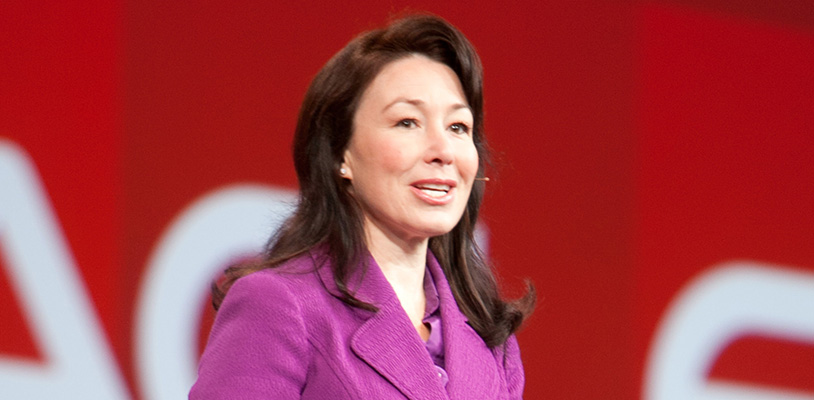However, for the world’s women leaders, this presents a frustrating conflict. Research from 2018 described how “paradoxical tensions exist between agency and communion because they are associated with distinct, and at times conflictual, cognition, behaviour, and motivation.” In short, says the research, you must be both warm and nice AND competent and tough.
A 1998 study[i] into the differences between men and women in the workplace shows that little has changed over the last two decades: it found that women were described as ‘emotional’, ‘weak’ and ‘dependent’, while men were associated with higher levels of ‘mastery’, greater assertiveness and individualism.
While men are expected to be – and rewarded for being – competent and tough, women who display the same traits are accused of being aggressive. Those who display the ‘warm and nice’ traits described in the 2018 paper are seen as weak and emotional.
Carly Fiorina, former CEO of HP and 2016 US Republican presidential candidate, says she is routinely referred to as either a bimbo or a bitch. As a leader of a global company and aspiring head of the free world, her significant talents, skills and accomplishments (she was the first woman to take control of a Fortune 100 company, created one of the most successful initial public offerings in US history, and named the most powerful woman in American business) were reduced to two derogatory words used to keep women firmly in their place.
Ultimately, we need to change societal expectations, but - as research spanning 20 years shows – this isn’t a quick or easy task. IWD2020 urges us to “challenge stereotypes” and “fight bias”. But how can we do this if, when we do so, we’re seen as bossy and bitchy, rather than confident and assertive?
Focusing on self-development, demonstrating competence and achieving results are traits all successful leaders should exhibit. However, while successful women in leadership positions have no problem in evidencing these skills, they tend to be far less vocal than men when it comes to celebrating them. Unsurprisingly, self-promoting women face a backlash that is not experienced by men[ii]
Women make up 31% of employees at graduate level, 27% of managers, 26% of senior managers or directors, 24% of vice presidents and only 19% of senior vice presidents or the C-suite.
But self-promotion is essential if we’re going to tackle this gender imbalance, celebrate the achievements of women and ensure they achieve the recognition for their success. At the same time, we need to give younger or less senior talented women the opportunity to emulate the behaviour of someone they identify with.
First, we need to be much clearer about the importance of diversity in the workplace, something IWD2020 urges us to do by raising awareness against bias and taking action for equality. It’s no easy task: according to Women in the Workplace, women are at a disadvantage which increases steadily throughout their career. Women make up 31% of employees at graduate level, 27% of managers, 26% of senior managers or directors, 24% of vice presidents and only 19% of senior vice presidents or the C-suite.
One proven way to counteract this bias is to give women role models. A University of Minnesota study[iii] showed that economic and social behaviour was significantly affected by a series of identity traits; those who were shown someone more similar to themselves in a work situation had a significantly increased level of engagement. Developing formal mentoring schemes and pairing young talent with female leaders – preferably with other similar economic and social traits – gives talented young women someone familiar to emulate.
However, before we can help women to progress, we must ensure that they are given opportunities, to begin with. There should be very clear recruitment criteria to ensure the best candidate is given the position, but if there are male and female candidates who are equally qualified and suited to the role, current figures mean that we would need to appoint and promote more women than men for decades to redress the balance. This presents a problem in itself – cries of reverse gender discrimination give women yet another obstacle to overcome to prove that they’re in their role because of merit, rather than to meet a tick-box exercise in diversity.
“Individually, we're all responsible for our own thoughts and actions - all day, every day. We can actively choose to challenge stereotypes, fight bias, broaden perceptions, improve situations and celebrate women's achievements.”
It’s a catch 22, and there’s a long way to go before the gender imbalance is evened out. While we wait for society to catch up, how do leaders – male and female - approach this situation? How can we attempt to tackle such an unfair disadvantage that we experience in all walks of life, not just in the boardroom?
According to the organisers of International Women’s Day 2020, we should be “celebrating women's achievements and increasing visibility, while calling out inequality”. There are companies who are working hard to address this: Fujitsu’s ‘Stand Out’ programme appoints female role models within the business who are supported by internal and external communications teams to share their success stories via blogs and social media posts; Accenture’s ‘Getting to Equal’ strategy provides a global digital platform where women can share advice, insights and experience, and are given personalised mentoring and training for self-development. All positive steps.
Harvard Business Review’s article exploring the 2018 research into how women balance the gendered norms of leadership described four paradoxical areas identified by the paper’s authors. With the right tools and techniques, it is possible to achieve a balance.
- Be demanding and caring.
It’s absolutely fine to be demanding and stretch people – as long as you support them to achieve the goals you set them and help them to focus on self-development.
- Be authoritative yet participative.
Authority is about setting vision and clarity – where are we going and how will we get there? Focusing on clear objectives but ensuring that you include people’s views and ideas about how you achieve those objectives creates strong and impactful leadership.
- Advocate for yourself while serving others.
Leaders and managers should consult their own leader about their personal aspirations and ask for feedback about how these can be achieved. Developing your own career while advocating for the needs of the team is a basic requirement in leadership, and scheduling regular conversations with mentors and superiors to discuss successes and shortcomings is essential.
- Maintain a distance but be approachable.
Honesty is the best policy. Strong communication and leading by example will ensure you are a strong influencer with integrity.
As the IWD2020 organisers say: “Individually, we're all responsible for our own thoughts and actions - all day, every day. We can actively choose to challenge stereotypes, fight bias, broaden perceptions, improve situations and celebrate women's achievements.”
And we can start in the boardroom by giving women the recognition they deserve, without resorting to derogatory labels.
Susy Roberts is an Executive Coach and Founder of people development consultancy Hunter Roberts.
[i] Barry J. Babin and James S. Boles, Employee Behavior in a Service Environment: A Model and Test of Potential Differences between Men and Women. Journal of Marketing Vol. 62, No. 2 (Apr., 1998), pp. 77-91 [ii] Corinne A. Moss-Racusin and Laurie Rudman, Disruptions in Women's Self-Promotion: The Backlash Avoidance Model. Psychology of Women Quarterly (May 2010) pp. 186-202 [iii] Avner Ben-Ner, Brian P. McCall, Massoud Stephane and Hua Wang, Identity and Self-Other Differentiation in Work and Giving Behaviors: Experimental Evidence. Journal of Economic Behavior & Organization 72 (October 2009) pp. 153-170











